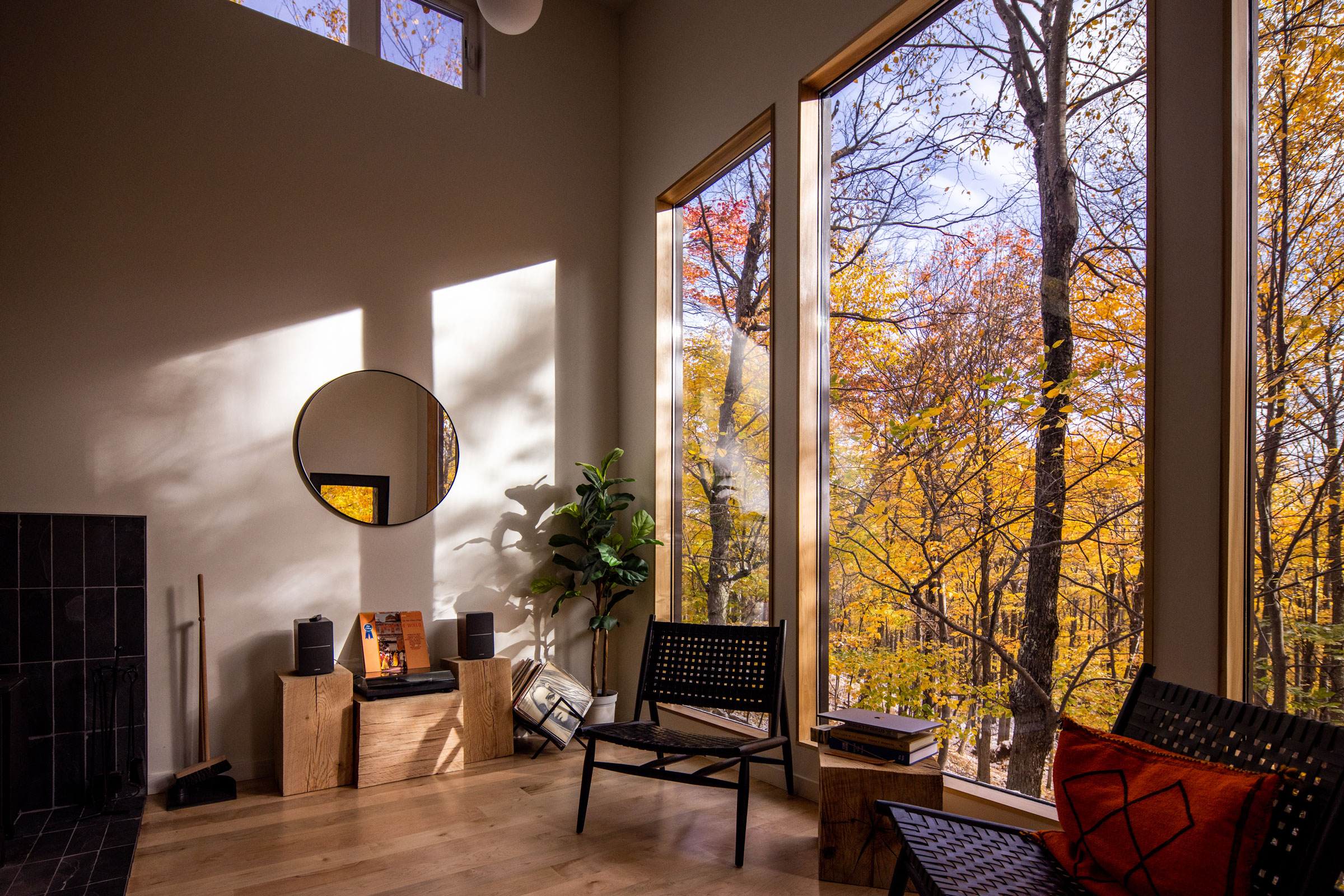Story at a glance:
- Introducing potted plants and trees is one of the simplest and most popular ways to bring the outdoors in.
- Using picture windows, floor-to-ceiling windows, and corner windows to frame views and highlight landscapes can help create a connection between indoor and outdoor spaces.
- Building with natural materials, furnishing with natural fibers, and decorating with natural items can help bring occupants closer to outdoors through their intrinsic link to the natural world.
At a time when the average American spends 90% of their time indoors and approximately 100,000 US citizens don’t have readily available access to green spaces, it’s more important than ever to find ways to connect with the natural world.
This notion is fundamentally grounded in biophilia, or the idea that, like air and water, the human need to connect with the natural world is hardwired into our genetics and is crucial to ensuring a healthy, fulfilling existence. From an architectural standpoint this concept manifests as biophilic design, a design philosophy that seeks to intentionally connect a building’s occupants—either directly or indirectly—with the natural world.
In this article we’ll explore 26 tips, tricks, and trends for how to bring the outdoors inside in 2024.
How to Bring the Outdoors In
1. Add Potted Plants & Trees
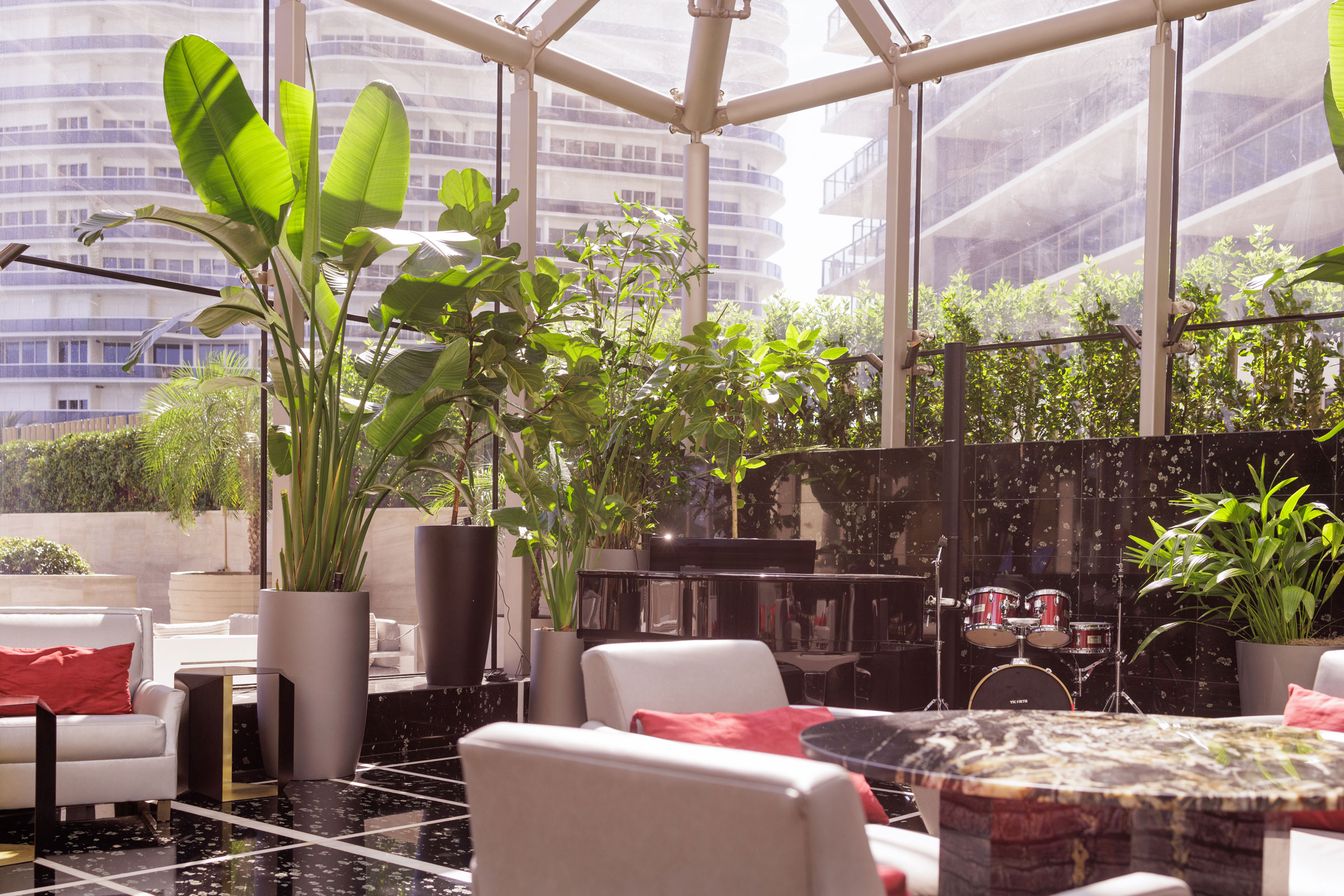
Plants can bring the divide between interior and exterior. Photo courtesy of Ambius
As perhaps the simplest means of bringing the outdoors in, incorporating houseplants is a great way to bring color and life into any interior space. Some of the most popular varieties include the spider plant, rubber plant, orchids, peace lily, ≥,m nbvand various ferns.
Adding potted trees can also help fill up free space and liven up empty corners, with species like dracaena, fiddle leaf fig, parlor palm, and money tree being the most common selections. When choosing houseplants and indoor trees be sure to carefully consider their sunlight requirements, maintenance needs, and verify whether they are potentially toxic to pets.
Even those who don’t have much of a green thumb can still incorporate indoor greenery by choosing lower-maintenance varieties like succulents and air plants that require less attention.
2. Hang Vining Plants
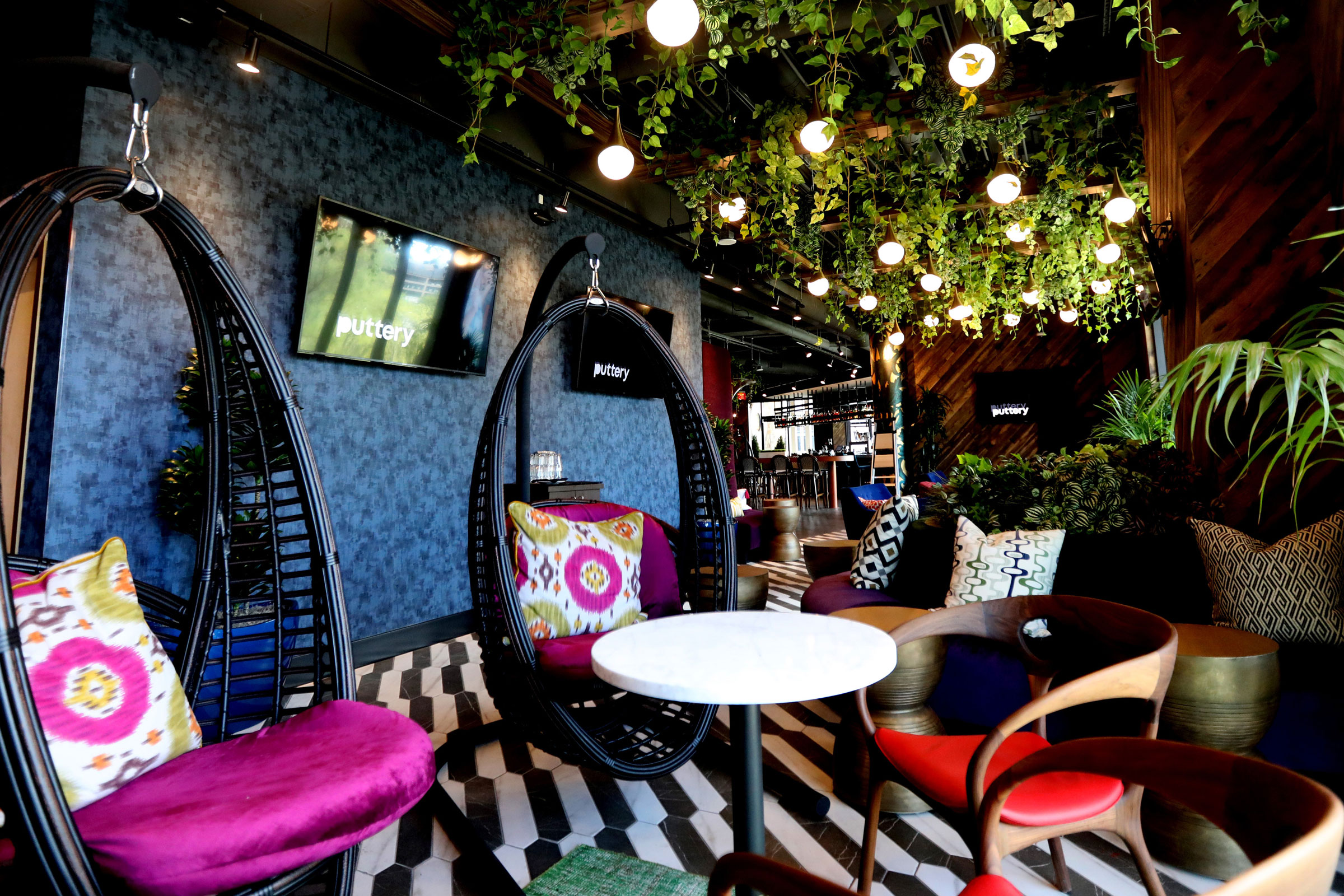
The trailing stems of hanging plants help create depth and add greenery to any interior space. Photo courtesy of Ambius
Distributing potted plants and trees throughout a space can be an effective way to bring the outdoors in, but for those who really want to feel immersed in nature without having to leave their home, the addition of vining plants can make all the difference. Typically hung from the ceiling or placed on high shelves, these plants provide not only greenery but also add depth thanks to their long trailing stems.
Some of the best trailing plants to hang inside include English ivy, string of hearts, pothos, philodendron micans, fishbone cactus, prayer plant, and spider plants.
3. Cultivate an Indoor Garden
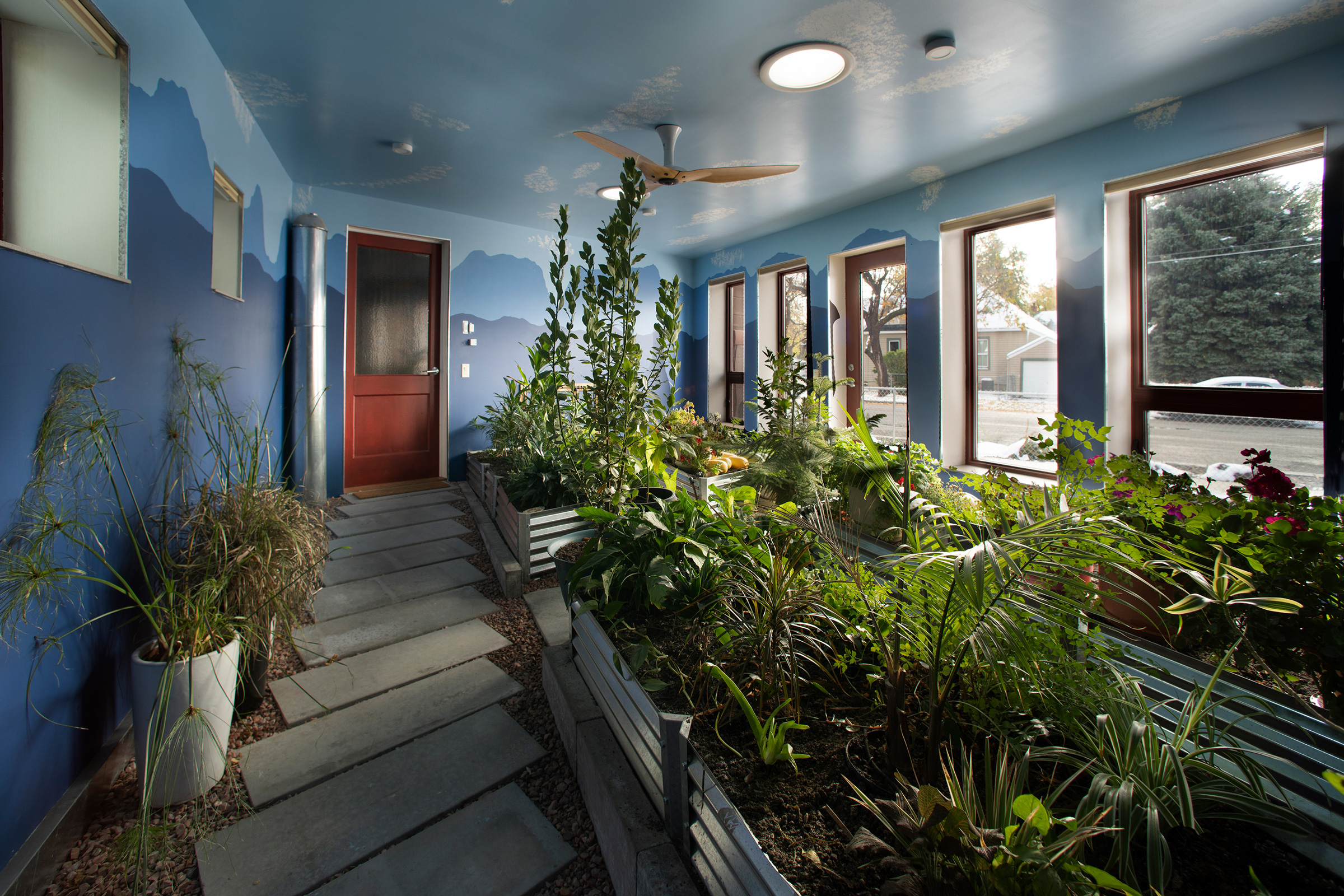
The home features a four-season Garden Room visible from the street through large windows. Photo by Clark Marten
Cultivating an indoor garden might seem like a herculean task but can be as simple as adding a few potted herbs to a well-lit windowsill. Herbs like basil, parsley, chives, mint, oregano, thyme, sage, and rosemary are all relatively beginner-friendly and are among the easiest plants to grow indoors. Households and owners with a bit more space and ambition can try growing vegetables or dwarf fruit trees in planters or even raised beds.
Not all indoor gardens have to have edible plants, though. The Urban Frontier House in Billings, Montana features a year-round indoor garden room with four raised beds that support a variety of species, the majority of which are non-edible.
4. Establish a Living Wall
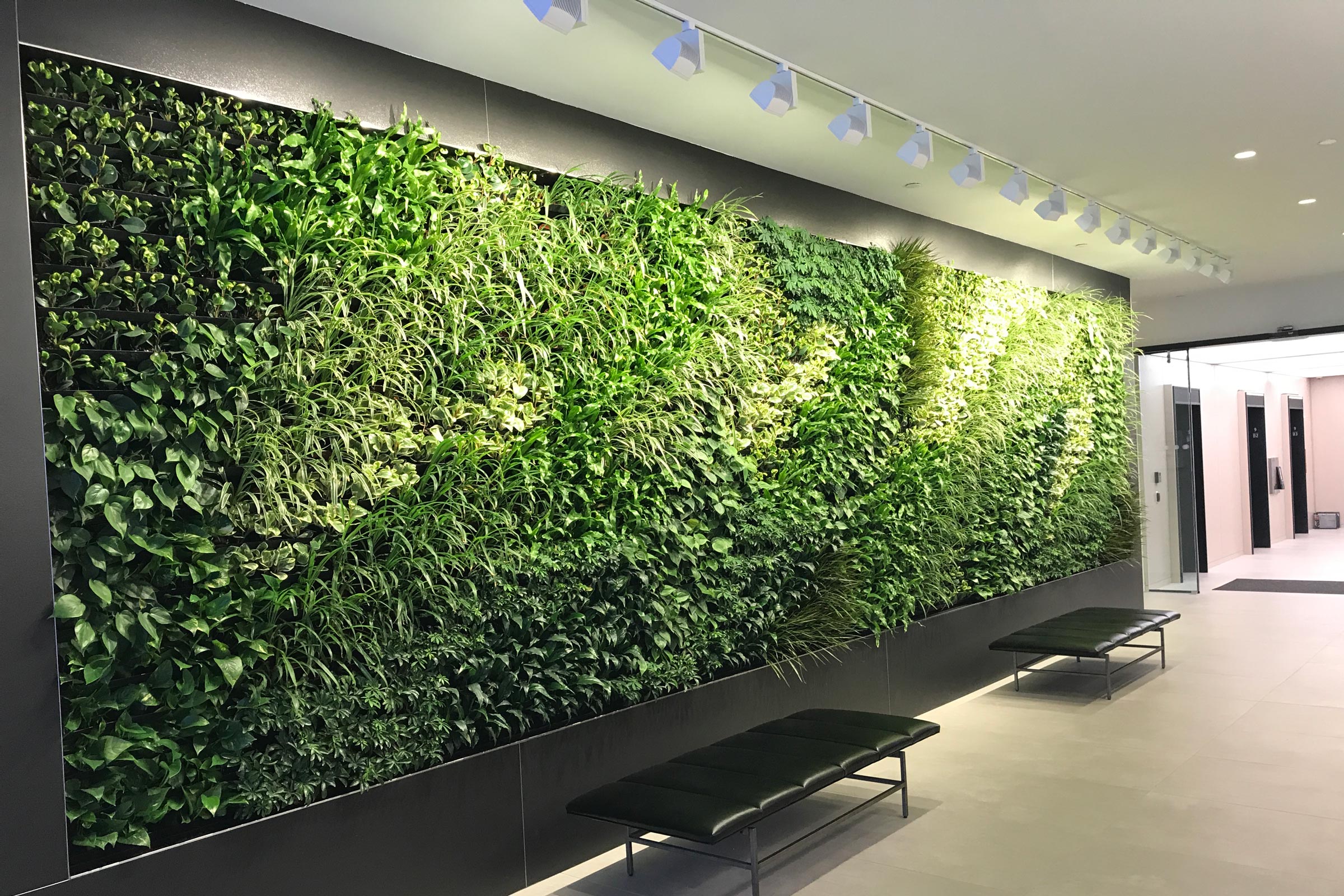
Biophilic design helps create a relaxing and rejuvenating home. Some options include adding a living wall, a green roof, or incorporating daylight design strategies. Photo courtesy of Lendlease Properties
Also referred to as green walls, living walls are vertical planting surfaces intentionally covered in vegetation and typically make use of either soil, some other sort of substitute substrate, or hydroculture felt as a growing medium. Unlike green facades, living walls can support a wide variety of both vining and non-vining plant and moss species and may be installed both indoors and outdoors.
Increasing occupants’ exposure to plants has a positive effect on the brain and even contributes to reduced feelings of anxiety and stress, lowered blood pressure, and improved alertness. “When you see a green wall you’re immediately drawn to it. It’s alive, it’s interesting, and it fulfills our biophilic needs. Plants make places nicer to hang out in, and they also help clean the air,” Matt Hills, a vertical garden and green wall expert at Ambius, previously wrote for gb&d.
Ambius is a global leader in creating smarter, healthier spaces through plants, green walls, scenting, holiday décor, and air purification.
5. Build Around a Mature Tree
This method takes a bit more planning than the rest, but building around an existing mature tree can be an extremely impactful means of bringing the outdoors in and makes for an incredible statement piece.
Building around an existing tree is also more sustainable than cutting it down and helps to reduce a structure’s overall environmental impact.
6. Design a Green Atrium or Conservatory
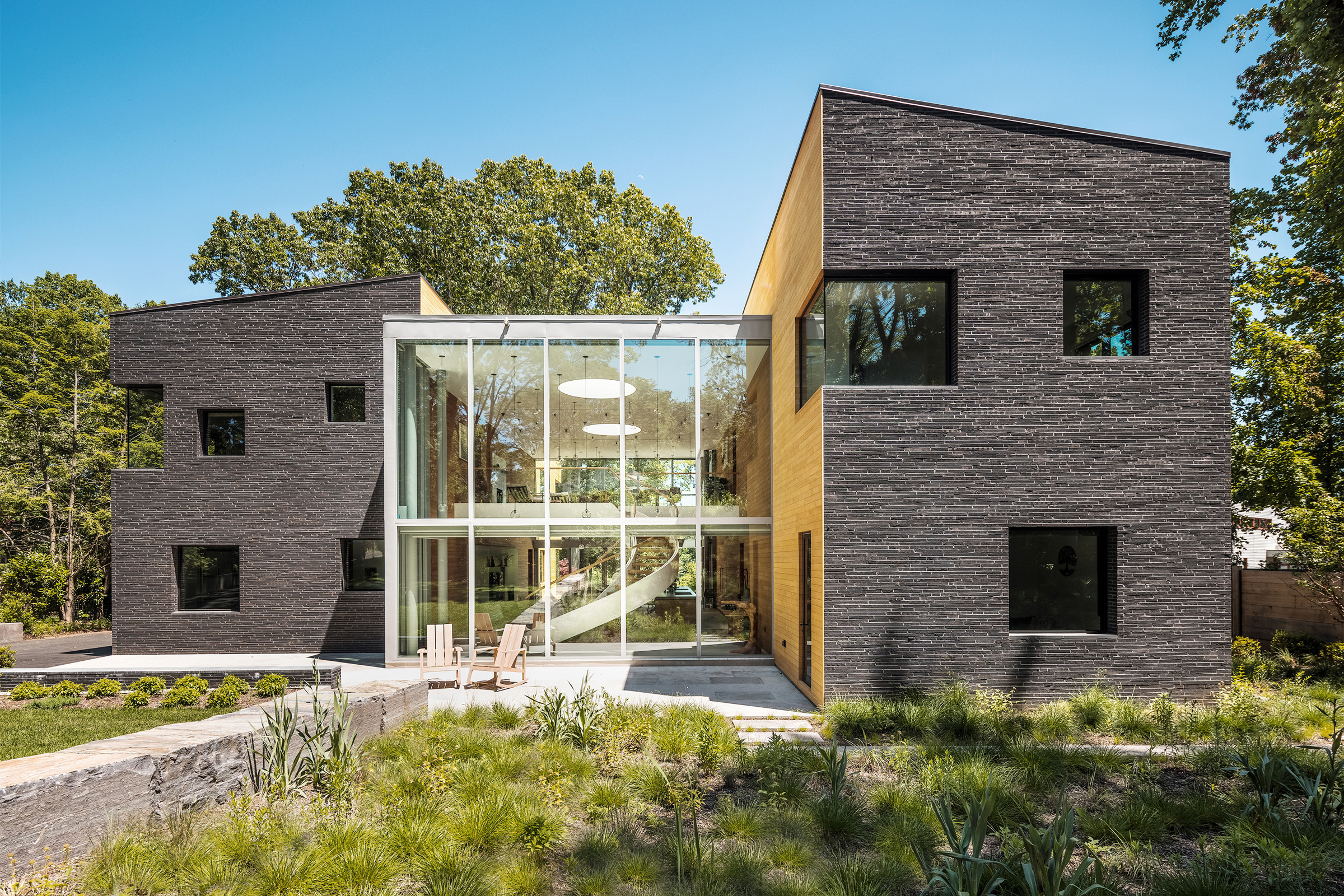
Designed by Studio PHH Architects, the La Clairiere House includes a central atrium that visually connects occupants to the outdoors. Photo courtesy of Glen-Gery
There are few better ways to bring in daylight and maximize indoor growing space than with a green atrium or solarium. Traditionally atriums—be they glass-walled or glass-roofed—have served to illuminate large centralized spaces in commercial structures, but they’re also found in residential projects. Atria are typically at least two stories high and provide occupants with both daylight and a visual link to the outside world, resulting in a dynamic lighting feature that is both impressive and practical.
Solariums are similar to atriums but are typically at the end or off the back of a home and feature walls and a ceiling entirely made from glass. Both solariums and atriums use thick glass to allow the sun to warm them even during colder months. They are ideal for growing plants that require full sun.
7. Install a Pergola

Renson’s Camargue Skye pergola can be outfitted with sliding glass panels and glass walls to create outdoor living spaces that provide year-round protection from the elements. Photo courtesy of Renson
You can also make access to nature easier year-round by adding an enclosed pergola. Renson believes you should be able to use your pergola year-round, rain or shine, no matter the temperature.
A leading manufacturer of sustainable outdoor living products, Renson offers a range of aluminum pergolas that use sliding glass panels, glass walls, translucent glass louvers, and even integrated heating to create highly flexible indoor-outdoor living spaces that provide protection from the elements without obstructing views.
“You can achieve 100% control of your space,” Andrea Zaghi, marketing manager at Renson, previously told gb&dPRO. “If you’re going to work from home, bring your kids outside, eat lunch outside with your family, it’s going to be easier because you can be out in the winter or summer, and you’re not going to have to think about it. You’re just going to have access to your space.”
8. Add a Terrarium or Aquarium
It’s one thing to bring plants into an interior space, but it’s another to include a miniature habitat that mimics the systems and processes found in various natural biomes. Terrariums, aquariums, and other ecological microcosms like paludariums and ripariums are all unique ways of bringing a slice of outside in while serving as an extremely interesting design features
The major difference between these is the amount of water they contain and the types of habitats they are designed to replicate:
- Terrarium. Sealed containers that include very little water (10% or less) and which are self-nourishing, using the released water vapor from plants and soil to constantly recycle water; often include various species of moss, lichens, and ferns.
- Paludarium. Sealed tanks that support a range of water amounts (between 10% and 90%) and which include both terrestrial and aquatic elements; typically designed to recreate swamp, stream, and rainforest biomes.
- Riparium. A tank that is mostly water (90% or more) with some land features and which looks to recreate natural riparian zones, or the areas that occur along the edges of bodies of water; typically includes both aquatic and semi-aquatic plants, fish, snails, and marine or freshwater crustaceans.
- Aquarium. Describes an enclosure filled entirely with water (100%) that is meant to mimic and replicate the ecological processes found in oceans and large freshwater bodies of water; typically includes aquatic plants, fish, invertebrates, amphibians, and even some aquatic reptiles.
Note that all require some maintenance, with some more difficult to take care of than others.
10. Frame Panoramic Views With Picture Windows
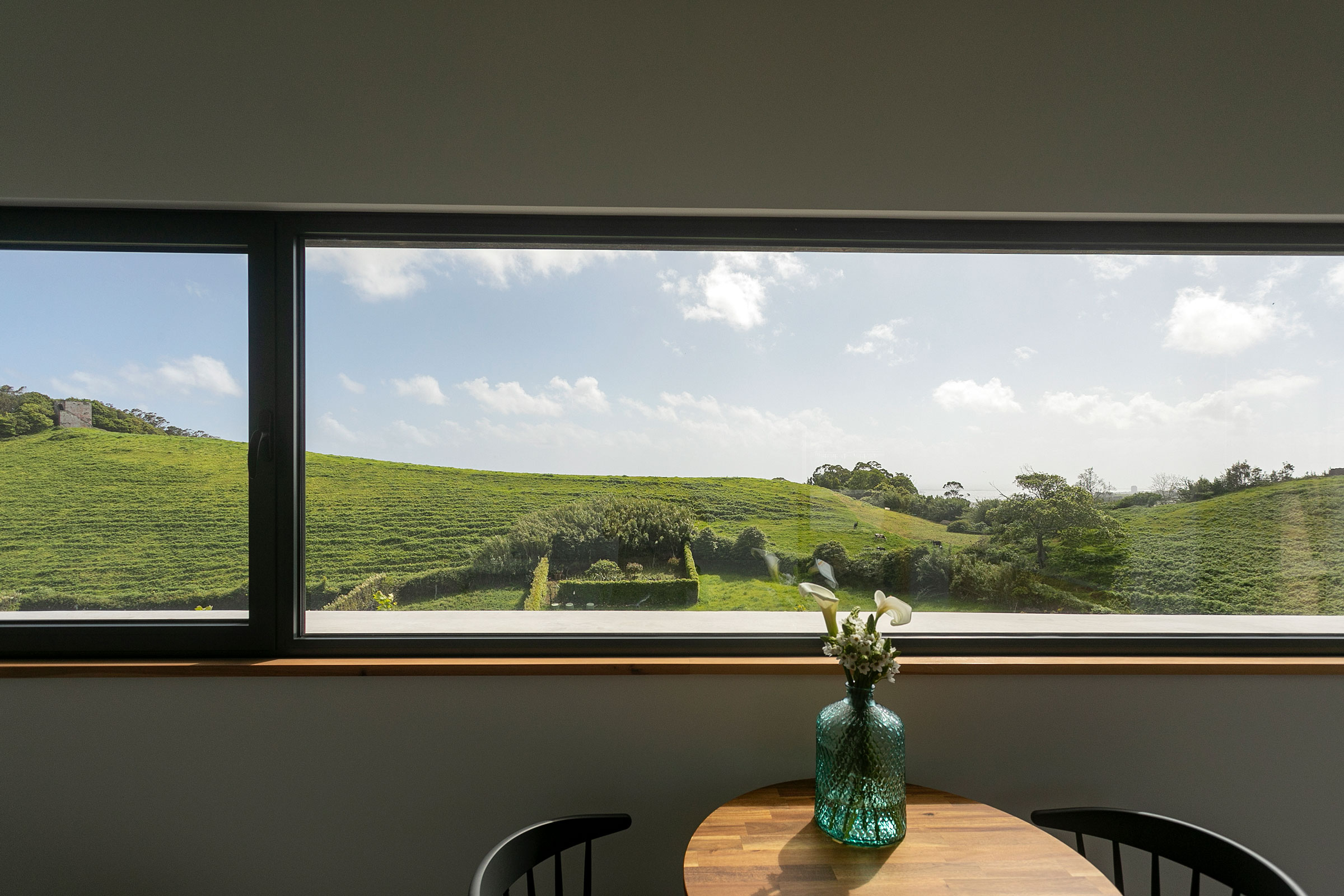
This picture window is strategically placed to offer a panoramic view of Azorean farmland. Photo by Rui Soares
Those fortunate enough to live in picturesque areas can bring the landscape indoors—at least figuratively—by strategically placing picture windows to frame panoramic views. Picture windows are a type of large statement window specially designed to highlight outdoor views.
These windows typically feature very simple, sleek frames and a single pane so as to provide an unobstructed picture of one’s outside surroundings, effectively turning the landscape itself into artwork.
11. Highlight Views With Floor-to-Ceiling Windows
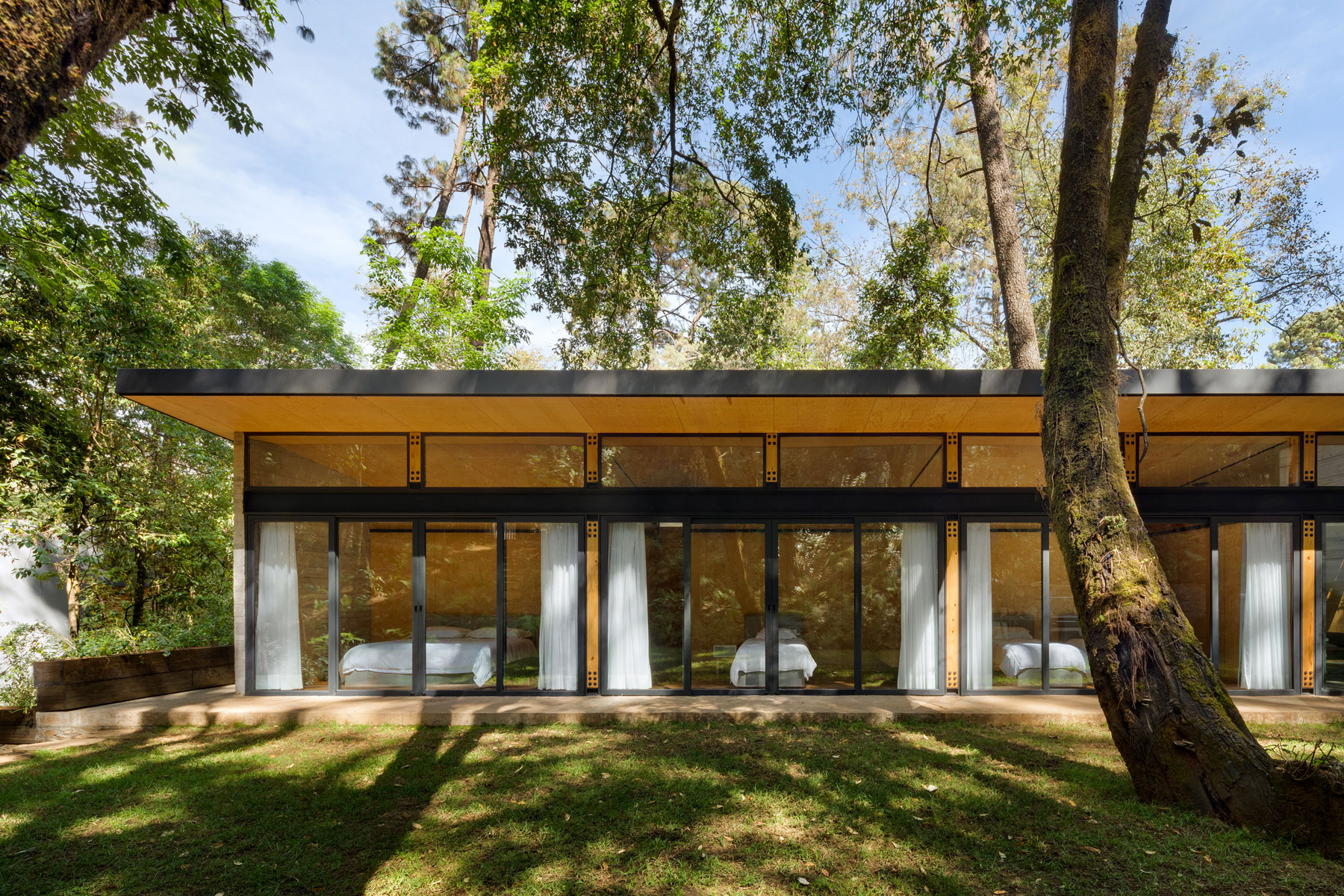
The south facade of this home is made of floor-to-ceiling windows and black aluminum frames, guaranteeing natural light and capturing maximum warmth to counteract the cold climate. The constant visual connection with the garden and the forest contributes to the tranquil atmosphere of the space. Photo by Rafael Gamo
Floor-to-ceiling windows are great for opening an interior space up to the outdoors and flooding it with natural light. These tall windows typically contain a single pane so as to provide an unobstructed view and maintain a constant sightline with the natural world, regardless of where the window is viewed from. When installed side-by-side, floor-to-ceiling windows can also help make rooms feel larger than they are.
“There’s a huge benefit of looking through a floor-to-ceiling window, even if you’re inside, and just feeling like you’re still in nature,” Peter Chlebogiannis, former marketing manager at Renson, previously told gb&dPRO. “The more space and connectivity—even visually—the better.”
12. Install a Corner Window
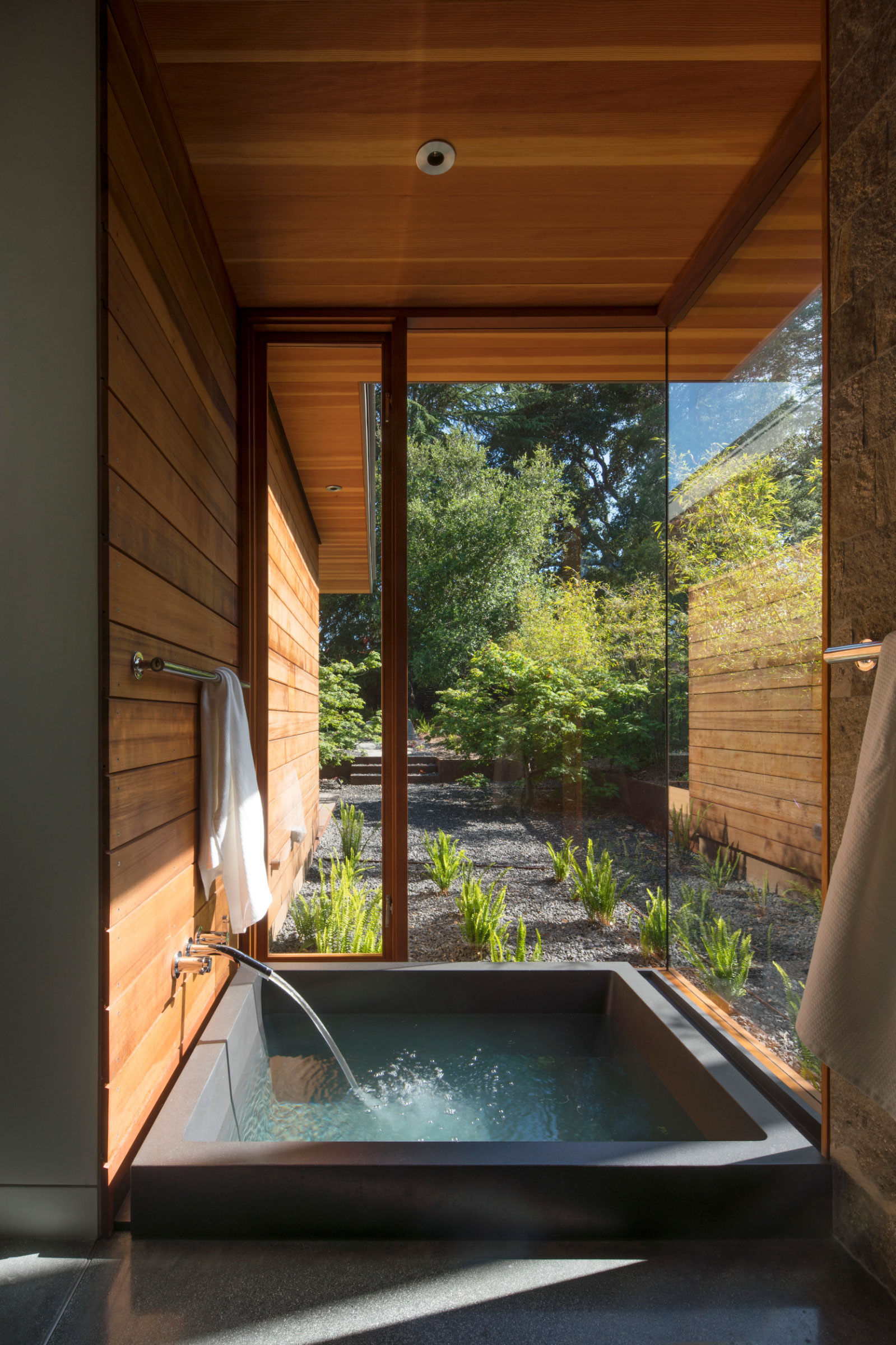
Cedar siding along the western edge of the residence extends inside the house. Photo by Nic Lehoux
To further break down the barrier between indoors and outdoors, consider installing a corner window to fully appreciate a beautiful view and let in the maximum amount of natural sunlight possible.
One of the most impressive types of corner windows is the frameless or glass-to-glass corner window, which consists of two panes of glass that meet at a corner—a design that effectively creates an invisible wall that serves as a striking focal point and offers unparalleled panoramic views.
13. Let the Light in With Skylights or a Light Well

A Hancock County, Kentucky courthouse design incorporated 16 TDDs in its green roof. Photo courtesy of JRA Architects
Natural daylight is a key feature in biophilic design and integral to both mental and physical health. “By exposing your body to daylight throughout the day, your healthy human circadian rhythm will have a significant role in regulating your sleep-wake cycle and have a positive influence on your eating habits and digestion, body temperature, hormone release, and other important bodily functions,” Neall Digert, vice president of innovation and market development at Kingspan Light + Air, previously wrote for gb&d.
Conventional windows are the daylighting standard, but skylights and light wells are also incredibly effective ways of letting the light in. Solatube—a company under the Kingspan Light + Air—offers innovative tubular skylights for both residential and commercial projects that are designed to deliver the maximum amount of sunlight into a space.
14. Invest in a Light Therapy Lamp
Not everyone is fortunate enough to live somewhere that receives adequate natural sunlight throughout the year, but there are ways to replicate the sun’s desirable qualities using modern technology. One way is using a light therapy lamp, a type of light fixture designed to mimic natural outdoor light, commonly used to help manage Seasonal Affective Disorder.
Like natural sunlight, light therapy lamps have a positive effect on the brain, encourage a healthy circadian rhythm, bolster productivity, and reduce feelings of stress, anxiety, and depression.
13. Enhance Natural Airflow
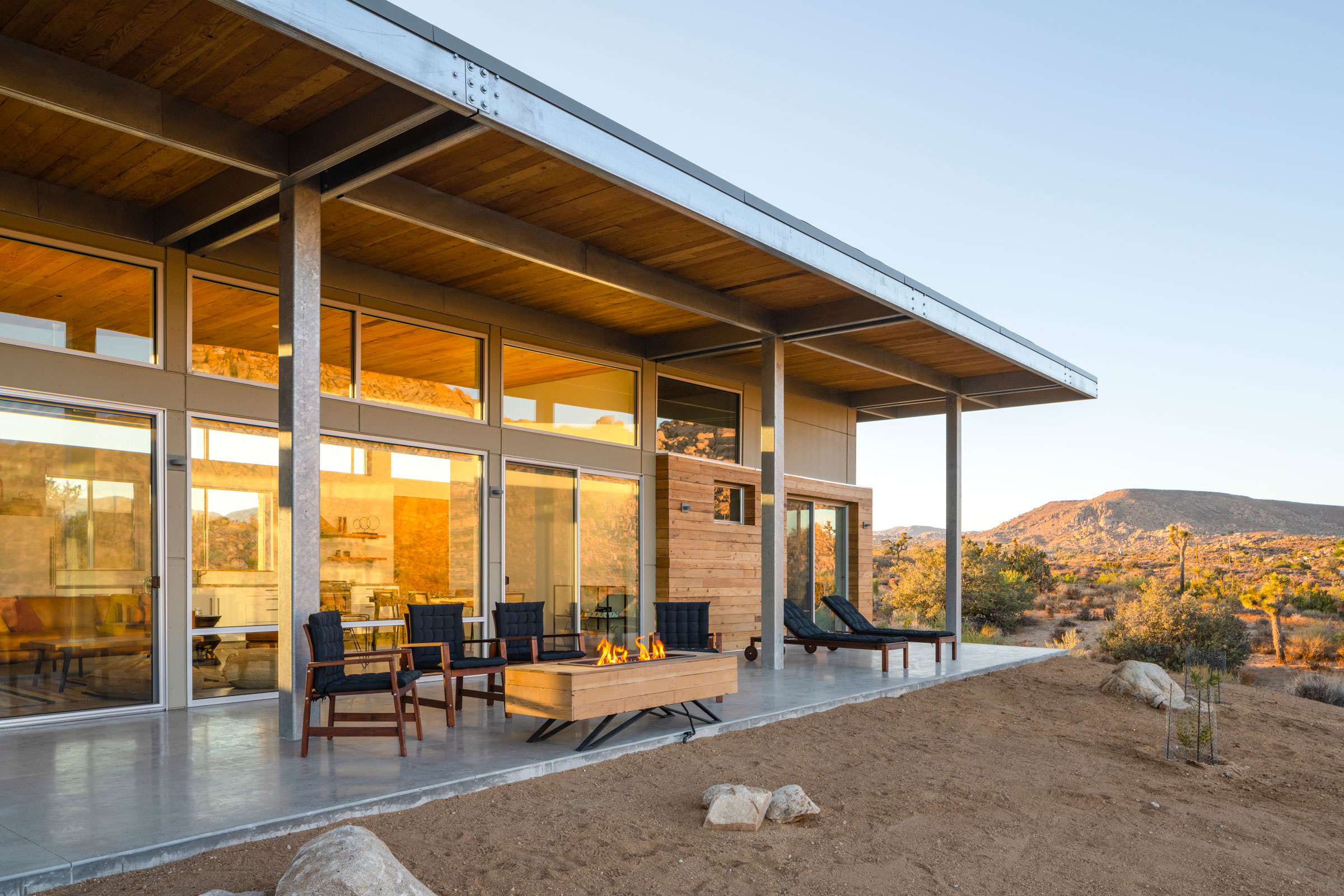
Designed by Jeremy Levine, the Cowboy Modern Desert Eco-Retreat uses passive solar design and wind-driven ventilation to reduce energy needs. Photo courtesy of Lance Gerber.
Natural airflow is an often overlooked component of biophilic design but one that has serious implications for human health and productivity. Studies have shown that breathing in fresh air helps improve oxygen flow to the brain, which in turn promotes enhanced cognitive function, memory retention, and concentration.
Passive ventilation systems use one of two natural processes—wind or thermal buoyancy—to facilitate the movement of air through a space by way of natural vacuums and volumetric pressure differences, such as those created by opening windows on opposite sides of a building.
Keep in mind, however, that opening windows is not recommended in homes and buildings in areas with poor air quality or on days where code orange or red air quality alerts have been issued.
15. Leave Wood & Other Natural Building Materials Exposed
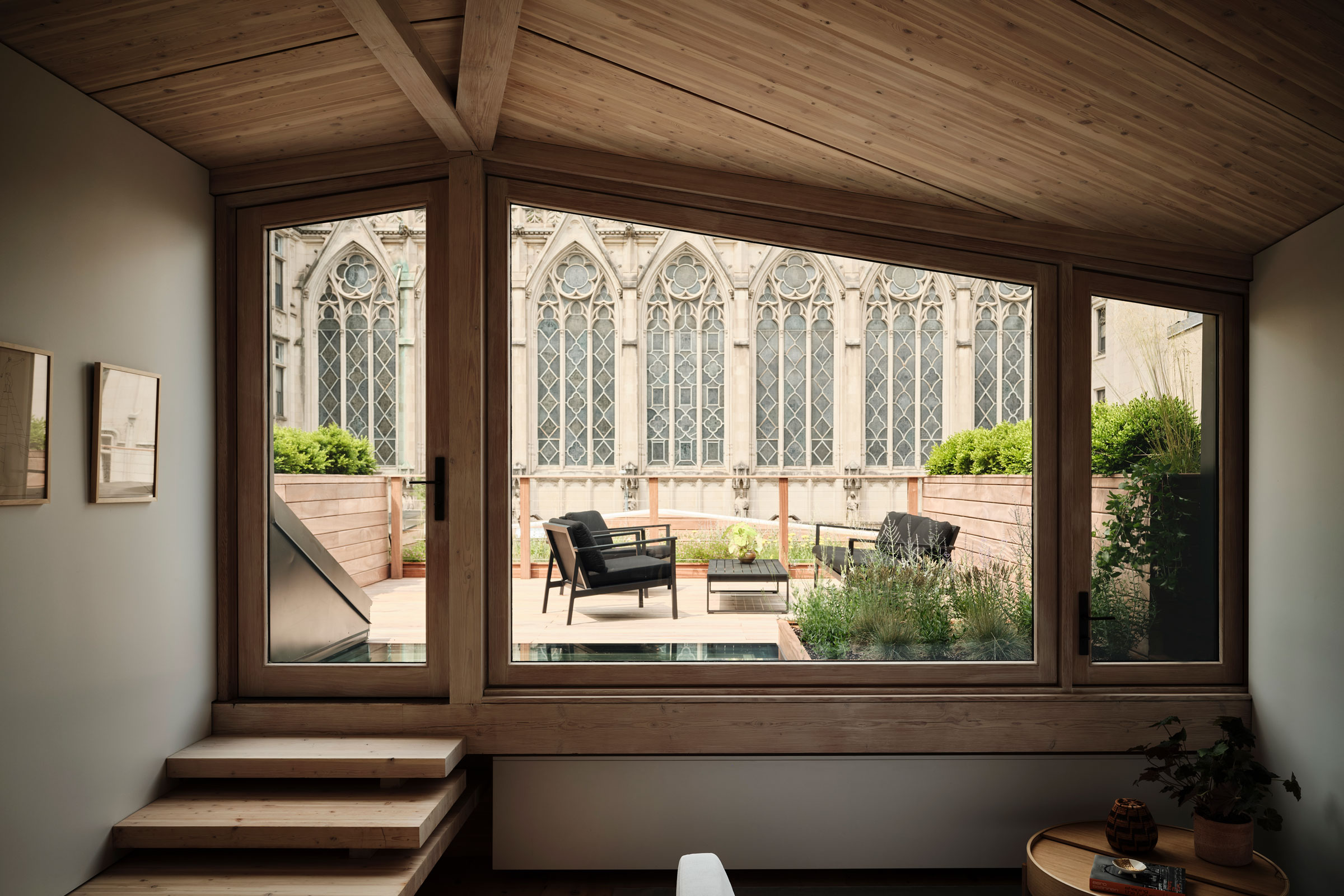
Architect Aaron Schiller’s Brooklyn home is largely constructed from mass timber, most of which is left exposed to create a warm, welcoming environment. Photo by Frank Frances
Building with natural materials like wood, bamboo, or stone and leaving those materials exposed can help foster a deeper connection to nature on a subliminal level. “The use of a natural material stimulates an innate and positive biophilic response in building occupants,” Scott Mooney, senior assistant at SRG Partnership, wrote in a previous gb&d article.
This is especially true of timber, as it provides an inviting warmth that less sustainable materials—namely concrete and steel—simply can’t contend with.
16. Create an Inner Courtyard
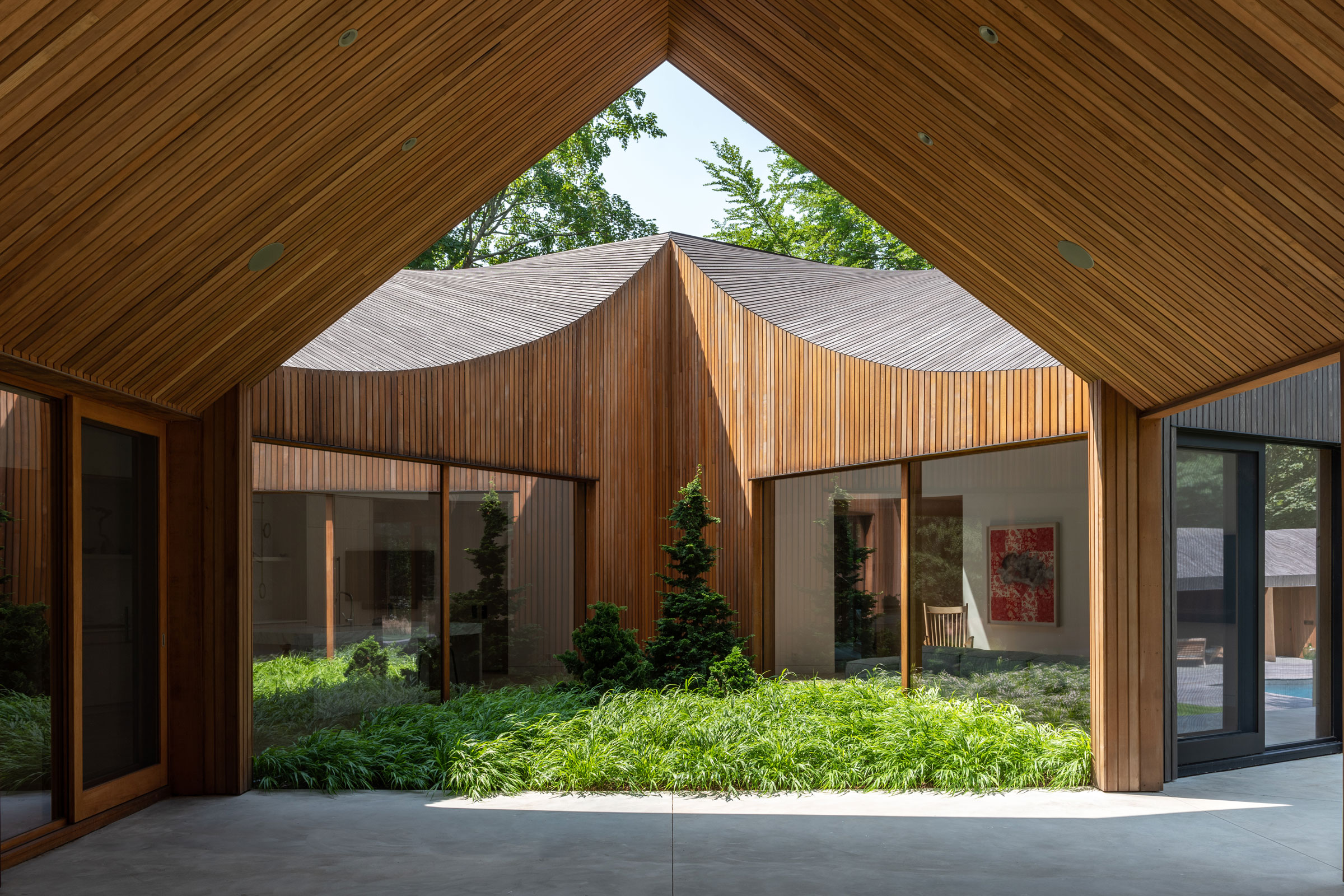
A polished concrete path leads to a triangular courtyard. The slatted roof aligns with slatted exterior walls to create long, vertical striations that begin at the roof ridge and cascade to the ground. Photo by Alan Tansey
Another way to connect occupants with nature is through the creation of a landscaped inner courtyard—a feature that quite literally introduces an outdoor area into the middle of a home.
Inner courtyards allow homes to make efficient use of daylight and natural ventilation by ensuring all rooms have at least one exterior-facing wall along which windows may be placed. This allows sunlight to reach even the innermost rooms and provides occupants with a visual connection to the outdoors wherever they are in the house.
17. Mirror Materials Inside & Out

The rear of the house features a wall of glass doors that open onto the back patio. Photo by Ivo Tavares
One innovative way to bring the outdoors in while creating the illusion of a larger interior space is to mirror the materials used inside with those in adjacent outdoor spaces.
A home with a dining room that connects to an outdoor patio space via a sliding glass door, for example, might use the same stone tile flooring in both spaces to create a cohesive material and color palette visible from either area. This creates a subtle transition, making it appear as though the dining room seamlessly connects to the outdoors.
18. Choose Natural Fabrics, Fibers & Textures
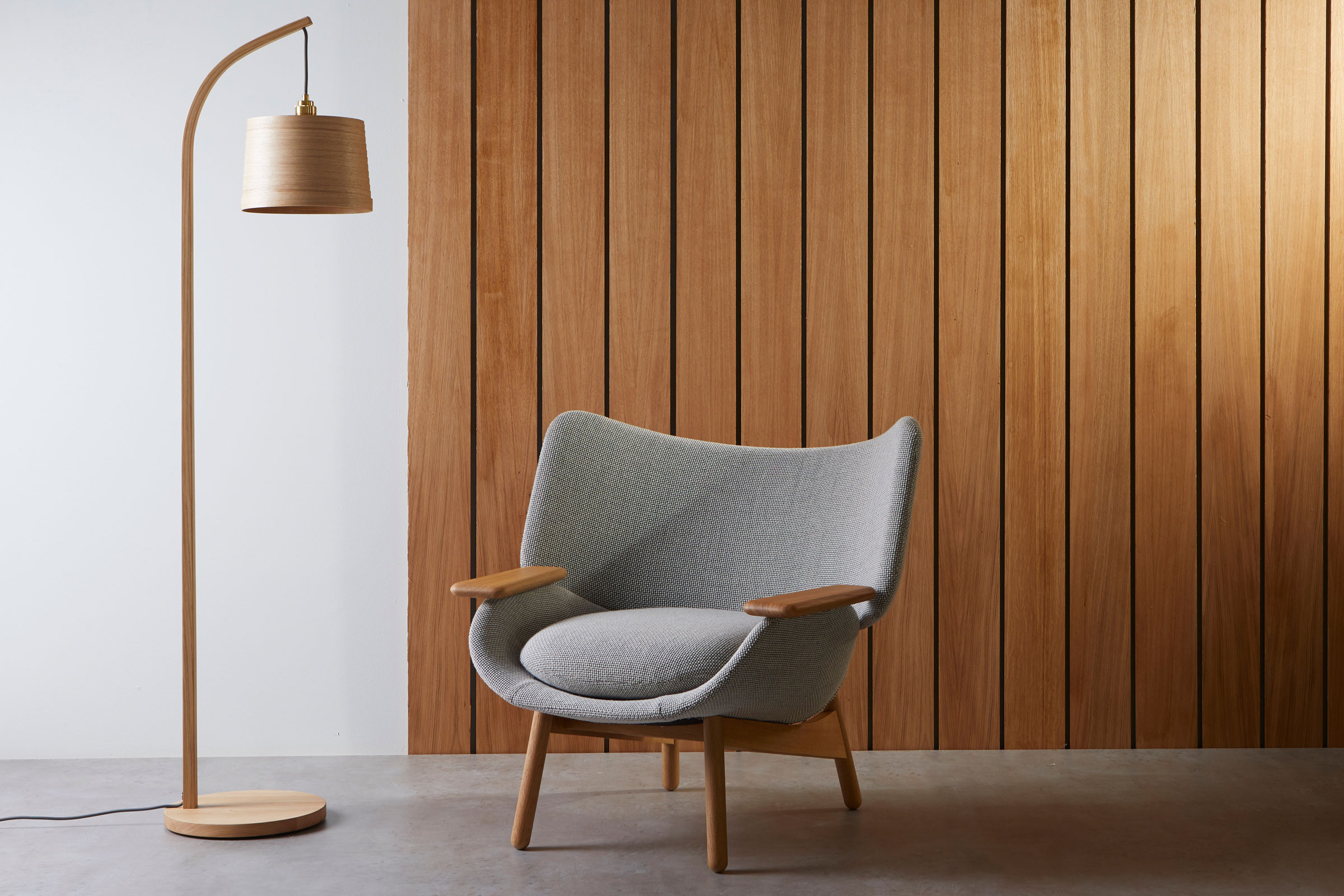
Crafted from a blend of wool and flax, the new Craggan Flax fabric retains the raw appeal of its natural composition while maintaining its contemporary aesthetic of a chunky weave. Photo courtesy of Camira
Choosing furnishings that utilize natural fabrics, fibers, and textures also reinforces a subtle connection to the outdoors. Materials like sheep’s wool, flax, jute, linen, and cotton all possess a simple, organic rawness that, when used to form rugs, tapestries, and furniture upholstery, helps create calm and relaxing indoor environments intrinsically linked to the natural world.
Camira—a company known for its low-impact textiles—offers a variety of fabrics suited to both commercial and residential upholstery applications, most of which are made using natural fibers. Camira’s Craggan Flax, for example, is a natural fabric made from a combination of wool and flax whose chunky weave gives it a unique textured quality that still retains the raw appeal of its organic composition.
19. Add Water Features
While not the easiest strategy for bringing the outdoors inside, water features are nevertheless important to consider when planning an interior space. Like exposure to daylight and plants, features like fountains and water walls can help reduce stress and anxiety, making for happier, healthier, more productive occupants.
“Adding water features, the sounds of running or splashing water, views of exterior water features, and pictures of waterbodies can add calm and connect people with nature,” Kelly Walowski, global account consultant for Ambius, previously wrote for gb&d.
Researchers have found that the very sight and sound of water induces a flood of neurochemicals and stimulates the parasympathetic nervous system, leading to increased blood flow to the heart and brain and inducing feelings of calm and relaxation.
20. Hang Landscape Photography
While not every household has access to stunning views through their windows, high-quality photographic prints of natural scenery and landscapes can be an effective stand-in for the real thing. This is because the simple act of observing nature or natural landscapes—whether real or represented in another medium—is good for the mind and body. Even if one can’t physically be outdoors, viewing natural scenery through photographs can reduce feelings of stress and anxiety, lowering cortisol levels, increasing parasympathetic nervous system activity, and improving concentration.
21. Add Nature-Inspired Art
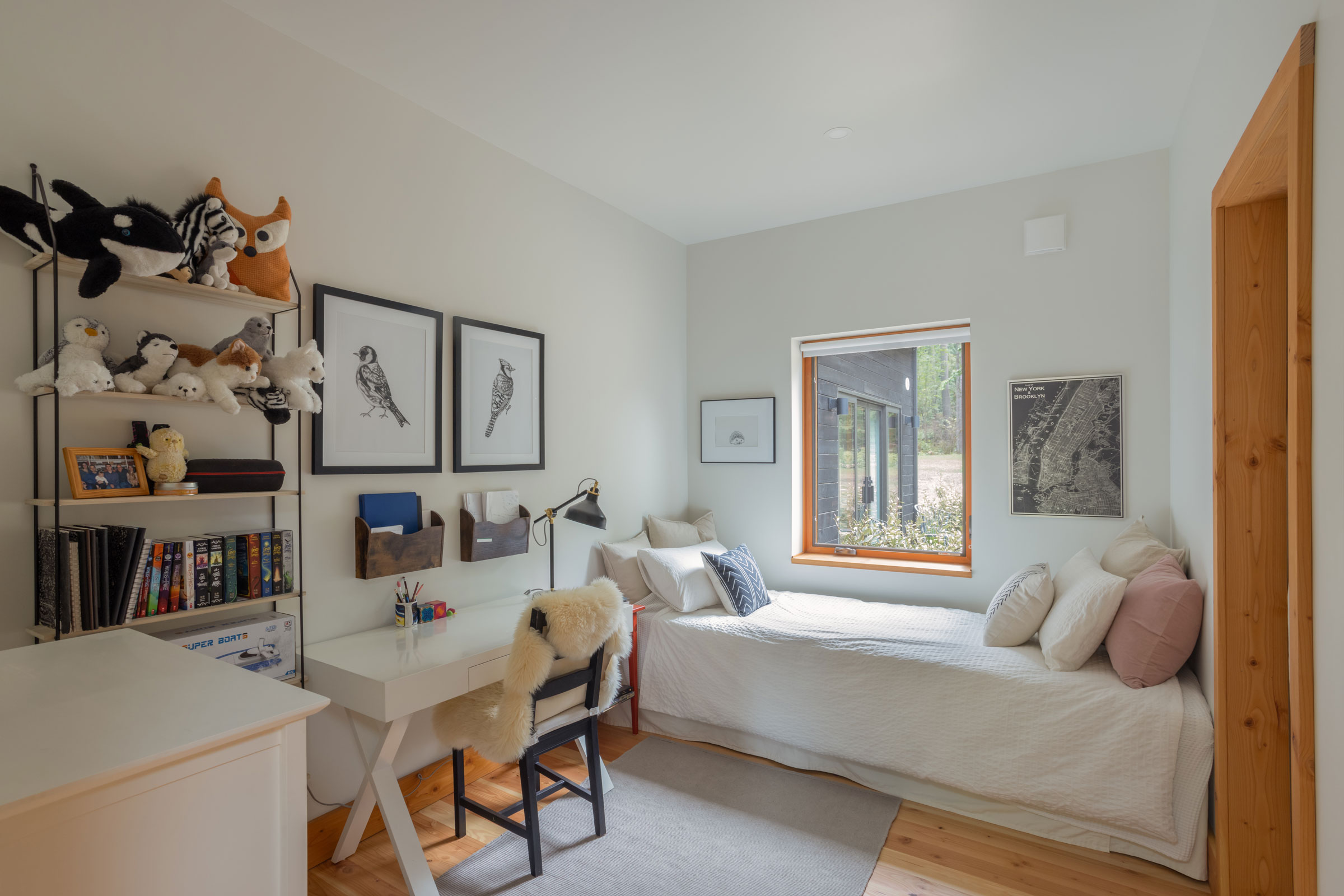
Nature-inspired art—like these two illustrated birds—is a subtle way to bring the outdoors in. Photo by Emily Hagopian
Similarly, one of the easiest ways to incorporate nature is through the use of imagery and graphics. This can be in the form of paintings, murals, wall art, wallpaper, and more. Including artistic depictions of local landscapes, environments, flora, and fauna is an excellent way to create a real sense of place and makes it easier for occupants to connect and relate to the world around them. Natural imagery also helps provide the brain with both emotional and intellectual stimulation.
22. Decorate With Items Found in Nature
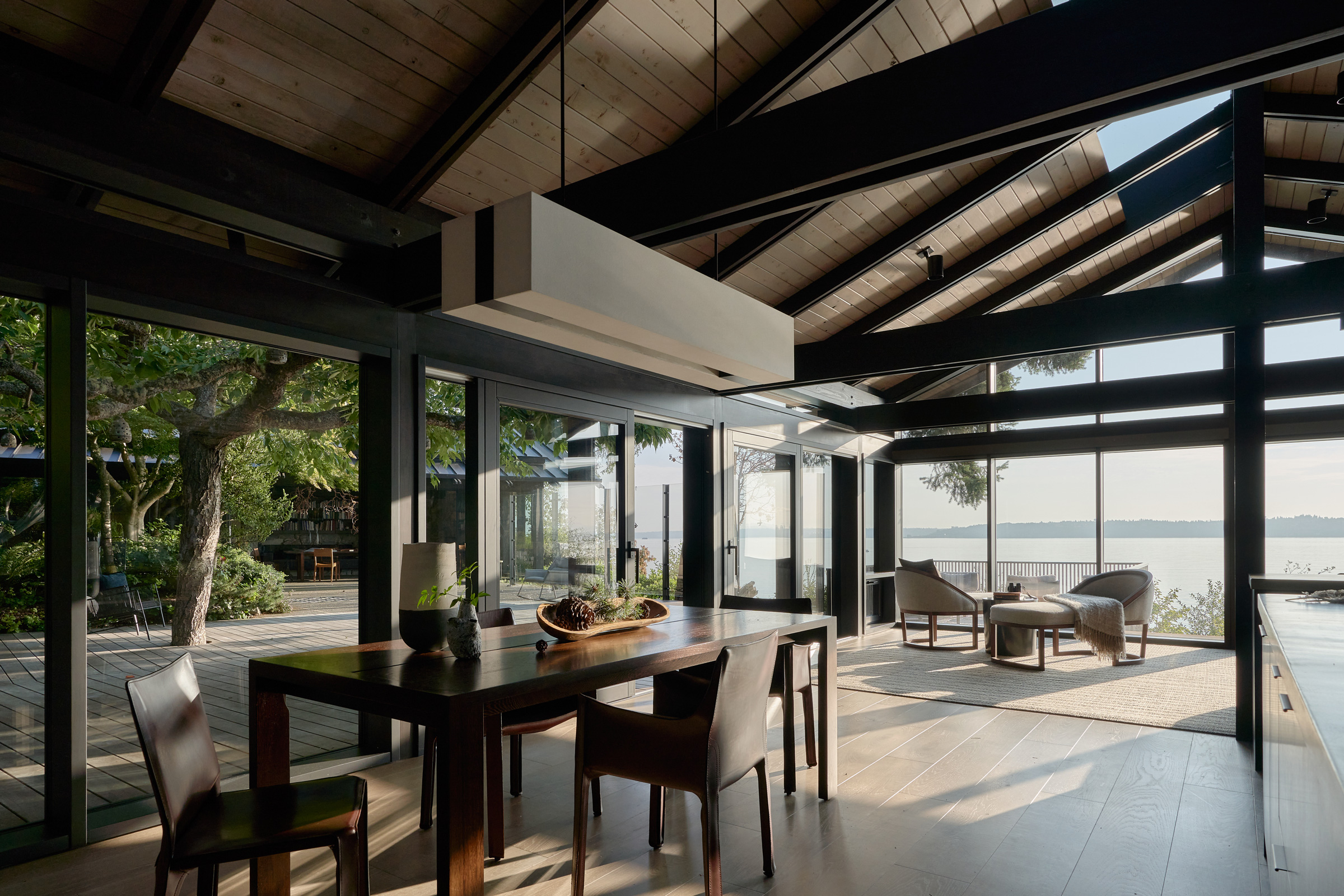
A pinecone and fresh pine branch make for a simple, natural centerpiece in this Washington home. Photo by Kevin Scott
One of simplest ways to bring the outdoors in is to quite literally bring the outdoors in—decorating with rocks, shells, driftwood, bones, fresh and dried flowers, pinecones, branches, and other natural items. Not only do these objects help subconsciously reinforce a connection to the natural world, they can also improve mood and productivity by helping to establish a calm, peaceful environment.
23. Incorporate Organic Patterns, Shapes & Geometries
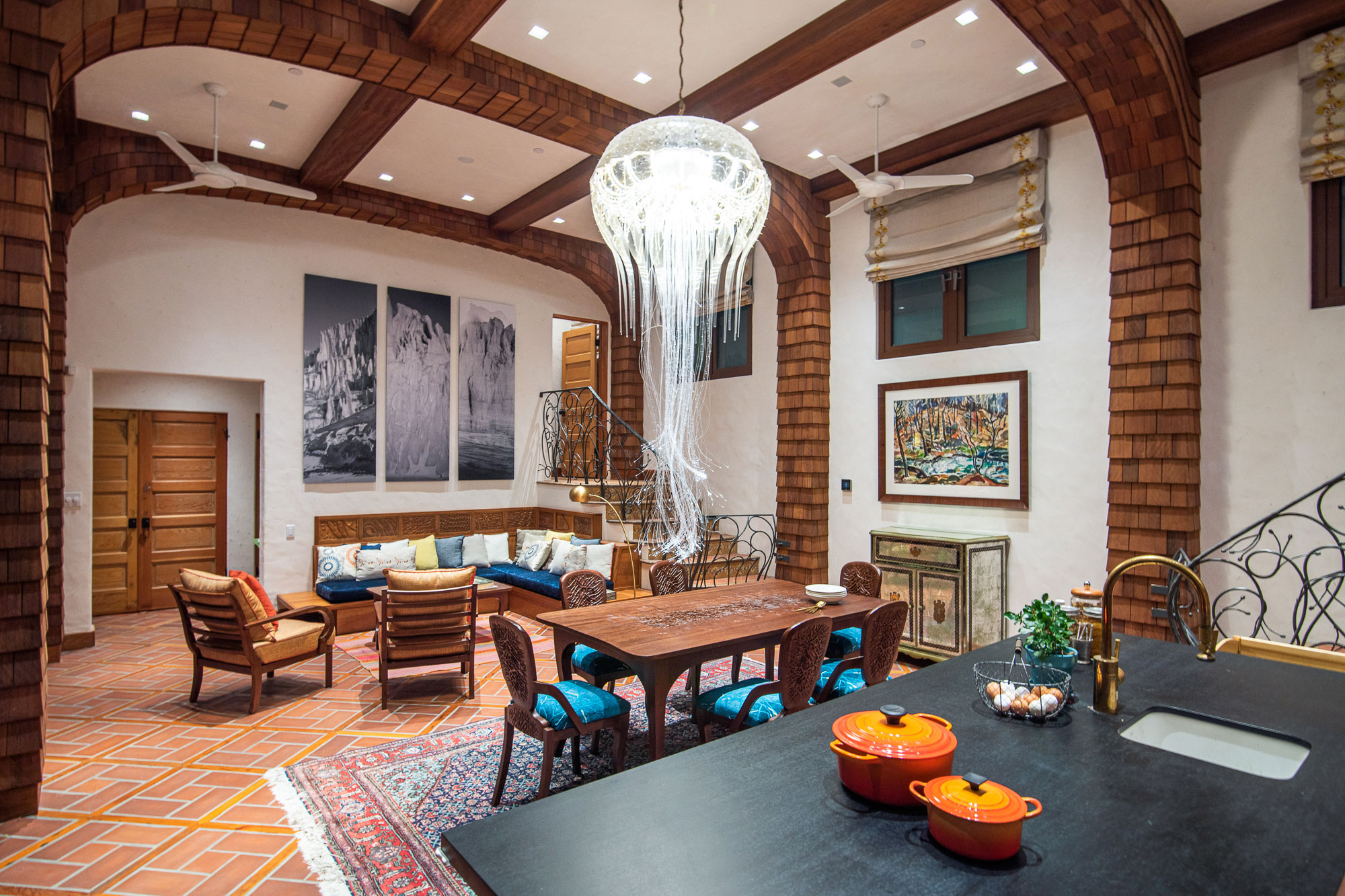
Sea creatures, fungi, bacteria, and other organic forms are celebrated in this Los Angeles residential design. Photo courtesy of CarbonShack
In lieu of imagery and graphics, nature may be invoked in an even subtler manner by way of organic shapes and patterns. These geometries are reminiscent of those commonly found in nature, and as such, are typically imperfect and irregular.
Organic shapes and patterns are generally characterized by curved lines as well as soft and uneven edges—qualities that tend to communicate comfort, familiarity, and approachability. “It’s the softness and the curves and repetition of patterns that are natural in origin. We automatically relate to it without even realizing it,” Ariel Lumry, interior project designer at Perkins&Will, previously told gb&d.
There are, however, also examples of more perfect organic geometries, such as the hexagonal honeycomb patterns found in beehives or the complex fractals—like the veins of a leaf—observed throughout the natural world.
24. Opt for an Organic Color Palette

A calming neutral color palette dominates the design inside the Casa Candela villas. Photo by César Bejar
Another indirect way of bringing the outdoors into interior spaces is to decorate using a natural color palette and organic earth tones. We often think of these colors as being limited to muted greens and browns, but earth tones encompass a wide color spectrum and are as varied as the environments they’re pulled from.
Dark greens, golden ambers, and rich browns, for instance, may be preferable to those living in forested regions, whereas soft tans, ruddy oranges, and dusty reds might be desirable to those who call the Southwest’s desert biomes home. Deep blues, muted purples, and smoky grays are also on the table for those looking to the mountains for inspiration, while sandy beiges, pastel blues, and pink corals help establish a coastal feel.
Macías Peredo Architecture Studio and Studio Habitación 116 used an organic color palette inspired by natural elements of Mexico’s Yucatan Peninsula when designing Candela Villa in Tulum. Tans, beiges, grays, and dark browns are found in abundance throughout the interior, creating a cohesive, calming environment.
25. Create Organic Soundscapes
While it’s true that modern design seeks to insulate the built environment against unwanted outdoor noise, that’s not to say that natural noises themselves are an issue. They can actually be quite beneficial in cultivating peaceful, calming indoor spaces. Natural sounds like leaves rustling in the wind, birds chirping, ocean waves crashing on the shore, and others not only foster a connection to the outdoors but also help create tranquil living environments.
26. Use Natural Scents

Natural scents are an often-overlooked way to bring the outdoors in. Photo courtesy of Ambius
It’s also possible to foster a deeper connection to the outdoors using scent. “Scent is one of our most powerful senses and is intrinsically linked to emotion and memory,” writes Walowski for gb&dPRO. Everyone has different aromatic preferences but scents like sandalwood, orange blossom, rose, cedar, lavender, jasmine, clary sage, and clove are all popular choices considered to be both earthy and calming.
Because the body’s sense of smell is closely linked to the limbic system—which is responsible for regulating memories and emotions—scents can also have a powerful effect on mood and cognition. Like many natural sounds, natural scents can help reduce feelings of anxiety and induce feelings of calm. Natural scents may be introduced to a space by way of candles, incense, reed diffusers, or through the materials themselves, either in the form of potpourri, fresh cut flowers, et cetera.

